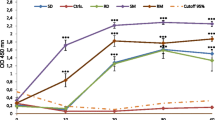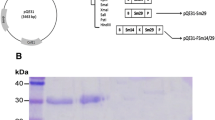Abstract
The purpose of the study is to explore the role of humoral immunity against Schistosoma mansoni infection in C57BL/6 mice using highly resistant rabbits that had been exposed to three separate immunizations with ultraviolet (UV)-irradiated cercariae (8,000 attenuated cercariae/rabbit in each immunization), and their sera were tested for their ability to transfer protection against S. mansoni challenge. The present study showed the reduction in challenge worm burden had reached 32.76–43.64% when compared with recipients of normal serum or no serum. The surface topography of the worms collected from immunized mice with either normal rabbit sera (NRS) or vaccinated rabbit sera (VRS) revealed severe tegumental alterations, especially in the VRS group. Worms collected from groups that were immunized by NRS or VRS postinfection (200 normal cercariae/mouse) by day 42. Worms from group immunized with NRS showed damage in the tegument, characterized by severe swelling or erosion of tegumental folds, accompanied by changes in tubercles, swelling, shortening, and loss of spines in male worms. The alteration in female tegument was characterized by swelling of tegumental folds, atrophy of ventral sucker, damage of sensory papillae along all the body, severe peeling in some regions, and appearance of few small blebs. VRS induced more severe tegumental damage than NRS in both male and female worms. Severe shrunken vesicles were protruded from the surface between the two suckers. The tegument of the male showed a collapse of tubercles followed by the appearance of vesicles on their surfaces, fusion, erosion, and superficial focal peeling of tegumental folds. In the female worms, severe damage to the oral sucker, the surface between the two suckers, extensive peeling, severe swelling of the tegument, and damage of sensory papillae. In conclusion, the present study support the hypothesis that high levels of antibodies were developed in rabbit sera after multiple exposures to attenuated cercariae of S. mansoni. Furthermore, immunization might have transferred protection against the infection, indicated by severe morphological alterations, a sign of elimination of the worms. Further investigation is being carried out to reveal the molecular mechanisms underlying the transfer of protection.




Similar content being viewed by others
References
Abath FGC, Werkhauser RC (1996) The tegument of Schistosoma mansoni: functional and immunological features. Parasite Immunol 18:15–20
Bergquist NR, Hall BF, James S (1994) Schistosomiasis vaccine development. Immunologist 214:131–134
Bickle QD, Andrews BJ, Doenhoff MJ, Ford MJ, Taylor MG (1985) Resistance against Schistosoma mansoni induced by highly irradiated infections: studies on species specificity of immunization and attempts to transfer resistance. Parasitology 90:301–312
Bin Dajem SM, Mostafa OMS, El-Said FG (2008) Susceptibility of two strains of mice to the infection with Schistosoma mansoni: parasitological and biochemical studies. Parasitol Res 103:1059–1063
Botros S, Sayed H, Amer N, EL-Ghannam M, Bennett JL, Day TA (2005) Current status of sensitivity to praziquantel in a focus of potential drug resistance in Egypt. Int J Parasitol 35:787–791
Caffrey CR (2007) Chemotherapy of schistosomiasis: present and future. Curr Opin Chem Biol 11:433–439
Chitsulo L, Engles D, Montresor A, Savioli L (2000) The global status of schistosomiasis and its control. Acta Trop 77:41–51
Cioli D (1998) Chemotherapy of schistosomiasis: an update. Parasitol Today 14:418–422
Cioli D, Pica-Mattoccia L (2003) Praziquantel. Parasitol Res 90:3–9
Cioli D, Botros SS, Wheatcroft-Francklow K, Mbaye A, Southagate V, Tehuenté LT, Pica-Mattoccia L, Troiani AR, Seif El-Dien SH, Sabra AA, Engels JD, Doenhoff MT (2004) Determination of ED50 values for praziquantel in praziquental resistance and susceptible Schistosoma mansoni isolates. Int J Parasitol 34:979–987
Doenhoff MJ, Kimani G, Cioli D (2000) Praziquantel and control of schistosomiasis. Parasitol Today 16:364–366
Doenhoff MJ, Cioli D, Utzinger J (2008) Praziquantel: mechanisms of action, resistance and new derivatives for schistosomiasis. Curr Opin Infect Dis 21:659–667
Fonseca CT, Brito CFA, Alves JB, Oliveira SC (2004) IL-12 enhances protective immunity in mice engendered by immunization with recombinant 14 kDa Schistosoma mansoni fatty acid-binding protein through an IFN-γ and TNF-α dependent pathway. Vaccine 22:503–510
Gönnert R, Andrews P (1977) Praziquantel a new broad-spectrum antischistosomal agent. Parasitol Res 52:129–150
Gryseels B, Polman K, Clerinx J, Kestens L (2006) Human schistosomiasis. Lancet 368:1106–1118
Hockley DJ (1973) Ultrastructure of the tegument of Schistosoma. Advances in Parasitol 11:233–305
Hockley DJ, McLaren DJ (1973) Schistosoma mansoni: changes in the outer membrane of the tegument during development from cercaria to adult worm. Int J Parasitol 3:13–25
Hoffmann KF, Strand M (1996) Molecular identification of Schistosoma mansoni tegumental protein with similarity to cytoplasmic dynein light chains. J Biol Chem 271:26117–26123
Hotez PJ, Molyneux DH, Fenwick A, Ottesen E, Ehrlich Sachs S, Sachs JD (2006) Incorporating a rapid-impact package for neglected tropical diseases with programs for HIV/AIDS, tubercolosis, and malaria. PLoS Med 3:e102
Jiraungkoorskul W, Sahaphong S, Sobhon P, Riengrojpitak S, Kangwanrangsan N (2005) Effects of praziquantel and artesunate on the tegument of adult Schistosoma mekongi harboured in mice. Parasitol Int 54:177–183
Kalapothakis E, Hirst E, Evans WH (1988) Pertubations of the topography of the tegument of adult Schistosoma mansoni. A scanning electron microscope study. Braz J Med Biol Res 21:1961–1969
Keiser J, Chollet J, Xiao SH, Mei JY, Jiao PY, Utzinger J, Tanner M (2009) Mefloqquine-an aminoalcohal with promising antischistosomal properties in mice. PLoS Negl Trop Dis 3:e350
Khon A, López-Alvarez ML, Katz N (1982) Transmission and scanning electron microscopical studies in the tegument of male Schistosoma mansoni after oxamniquine treatment. Ann Parasite Hum Comp 57:285–291
King CH, Dangerfield-Cha M (2008) The unacknowledged impact of chronic schistosomiasis. Chron Illn 4:65–79
Kruatrachue M, Upatham ES, Sahaphong S, Riengrojpitak S (1979) Scanning and transmission electron microscopy of Mekong Schistosoma eggs and adults. S Asian J Trop Med Publ Hlth 10:85–96
Lanning D, Zhu X, Zhai SK, Knight KL (2000) Development of the antibody repertoire in rabbit: gut-associated lymphoid tissue, microbes, and selection. Immunol Rev 175:214–228
Liang YS, Coles GC, Doenhoff MJ, Southagate VR (2001) In vitro responses of praziquantel resistant and susceptible Schistosoma mansoni to praziquantel. Int J Parasitol 31:1227–1235
Machado-Silva JR, Lanfredi RM, Gomes DC (1997) Morphological study of adult male of Schistosoma mansoni Sambon, 1907 by scanning electron microscopy. Mem Inst Oswaldo Cruz 5:647–653
Mangold BL, Dean DA (1986) Passive transfer with serum and IgG antibodies of irradiated cercariae-induced resistance against Schistosoma mansoni in mice. J Immunol 136:2644–2648
Mangold BL, Dean DA (1992) The role of IgG antibodies from irradiated cercariae-immunized rabbits in the passive transfer of immunity to Schistosoma mansoni infected mice. Am J Trop Med Hyg 47:821–829
Manneck T, Haggenmüller Y, Keiser J (2010) Morphological effects and tegumental alterations induced by mefloquine on schistosomula and adult flukes of Schistosoma mansoni. Parasitology 137:85–98
Mattos ACA, Pereira GC, Jannotti-Passos LK, Kusel JR, Coelho PMZ (2007) Evaluation of the effect of oxamniquine, praziquantel and a combination of both drugs on the intramolluscan phase of Schistosoma mansoni. Acta Trop 102:84–91
Mehlhorn H, Becker B, Andrews P, Thomas H, Frenkel JK (1981) In vivo and in vitro experiments on the effect of praziquantel on Schistosoma mansoni. Alight and electron microscopic study. Arzneimittelforschung 31:544–554
Miller FH, Tulloch GS, Kuntz RE (1972) Scanning electron microscopy of integumental surface of Schistosoma mansoni. J Parasitol 58:693–698
Mohamed SH (1999) Scanning electron microscopical studies on the tegument of adult worms of Schistosoma mansoni originating from ultraviolet-irradiated and nonirradiated cercariae. J Helminthol 73:157–161
Mohamed SH, Kamel MM (2000) Effect of cyclophospohamide mediated immunodeficiency on murine schistosomiasis mansoni. J Egypt Soc Parasitol 30:11–26
Mountford AP, Hogg KG, Coulson PS, Brombacher F (2001) Signaling via interleukin-4 receptor alpha chain is required for successful vaccination against schistosomiasis in BALB/c mice. Infect Immun 69:228–236
Murrell KD, Clarke S, Dean DA, Vannier WE (1979) Influence of mouse strain on induction of resistance with irradiated Schistosoma mansoni cercariae. J Parasitol 65:829–831
Popiel I, Irving DL, Basch PF (1985) Wound healing in the trematode Schistosoma. Tissue Cell 17:69–77
Riberio-Dos-Santos G, Verjovski-Almeida S, Leite LC (2006) Schistosomiasis-a century searching for chemotherapeutic drugs. Parasitol Res 99:505–521
Richter D, Incani RN, Harn DA (1993) Isotype responses to candidate vaccine antigens in protective sera obtained from mice vaccinated with irradiated cercariae of Schistosoma mansoni. Infect Immun 61:3003–3011
Ridley RG, Kita K (2007) Helminth drug initiative. Expert Opin Drug Discov 2:1
Rogers SH, Shannon WA Jr, Reeder RL (1983) Schistosoma mansonia adults: uptake and incorporation of epimeric monosaccharides by the tegument. Pro Okl Acada Sci 63:12–20
Sher AR, Coffman L, Hieny S, Cheever AW (1990) Ablation of eosinophil and IgE responses with anti IL-S or anti IL-4 antibodies fails to affect immunity against Schistosoma mansoni in mouse. J Immunol 145:3911–3916
Silva IM, Thiengo R, Conceica MJ, Rey L, Lenzi HL, Pereira Filho E, Ribeiro PC (2005) Therapeutic failure of praziquantel in treatment of Schistosoma haematobium infection in Brazilians returing from Africa. Mem Inst Oswaldo Cruz 100:445–449
Smithers SR, Terry RT (1965) Infection of laboratory hosts with cercaria of Schistosoma mansoni and the recovery of adult worms. Parasitology 55:695–700
Sornmani S, Kitikoon V, Schneider CR, Harinasuta C, Pathamma-Wong O (1973) Mekong schistosomiasis: 1. Life cycle of Schistosoma japonicum, Mekong strain in the laboratory. Southeast Asia J Trop Medicine Pub Hlth 4:218–225
Steinmann P, Keiser J, Bos R, Tanner M, Utzinger J (2006) Schistosomiasis and water resources development: systematic review, meta-analysis, and estimates of people at risk. Lancet Infect Dis 6:411–425
Utzinger J, Keiser J (2004) Schistosomiasis and soil-transmitted helminthiasis: common drugs for treatment and control. Expert Opin Pharmaco 5:263–285
van der Werf MJ, de Vlas SJ, Brooker S, Looman CWN, Nagelkerke NJD, Habbema JDF, Engels D (2003) Quantification of clinical morbidity associated with schistosome infection in sub-Saharan Africa. Acta Trop 86:125–139
Wales A, Kussel JR (1992) Biochemistry of irradiated passive vaccines: suggested models for their mode of action. Parasitol Today 8:358–363
WHO (1999a). Report of WHO informal consultation on schistosomiasis control, 2–4 December 1998. WHO/CDS/CPC/SIP/99.2, Geneva
WHO (1999b) Report of WHO informal consultation on monitoring of drug efficacy in control of schistosomiasis and intestinal nematodes, 8–10 July 1998. WHO/CDS/CPC/SIP/99.1, Geneva
WHO (2002) Prevention and control of schistosomiasis and soil-transmitted helminthiasis; report of a WHO expert committee, Geneva 2002. WHO Tech Rep Ser 912:1–57
WHO (2004) The global burden of disease: 2004 update. World Health Organization, Geneva
Xiao SH, Shen BG, Chollet J, Tanner M (2000) Tegumental changes in 21-old day Schistosoma mansoni haboured in mice treated with artemether. Acta Trop 75:341–348
Zhang CW, Xiao SH, Utzinger J, Chollet J, Keiser J, Tanner M (2009) Histopathological changes in adult Schistosoma japonicum harbored in mice treated with a single dose of mefloquine. Parasitol Res 104:1407–1416
Zhoui Y, Podesta RB (1992) Ring-shaped organization of cytoskeletal F-actin associated with surface sensory receptors of Schistosoma mansoni: a confocal and electron microscopic study. Tissue Cell 24:37–49
Author information
Authors and Affiliations
Corresponding authors
Additional information
Dr. Abdeen and Dr. Reda have equally contributed to this work
Rights and permissions
About this article
Cite this article
Abdeen, S.H., Reda, E.S., El-Shabasy, E.A. et al. Ultrastructural changes of adult Schistosoma mansoni worms recovered from C57BL/6 mice passively immunized with normal and vaccinated rabbit sera in vivo. Parasitol Res 110, 37–47 (2012). https://doi.org/10.1007/s00436-011-2448-7
Received:
Accepted:
Published:
Issue Date:
DOI: https://doi.org/10.1007/s00436-011-2448-7




